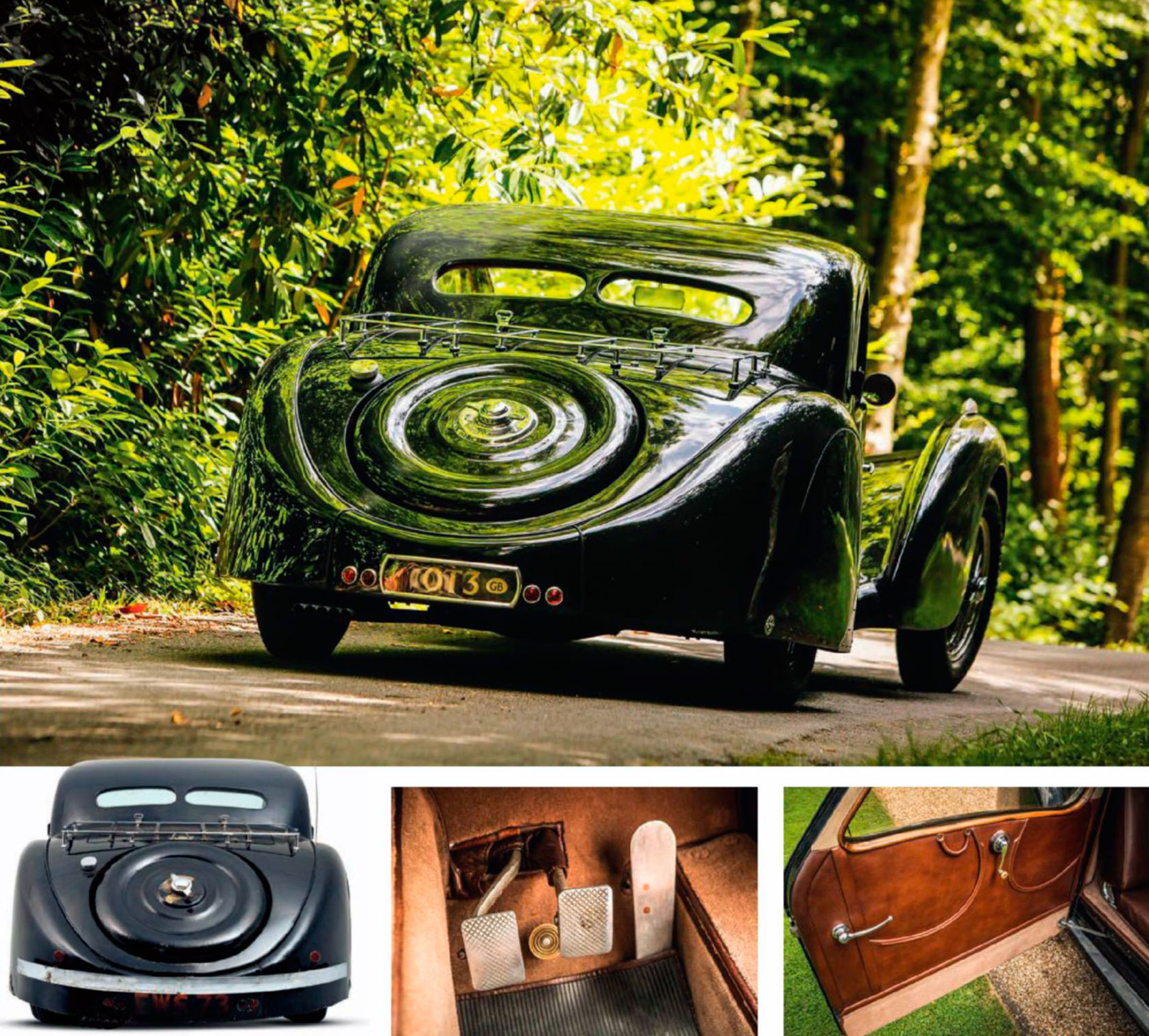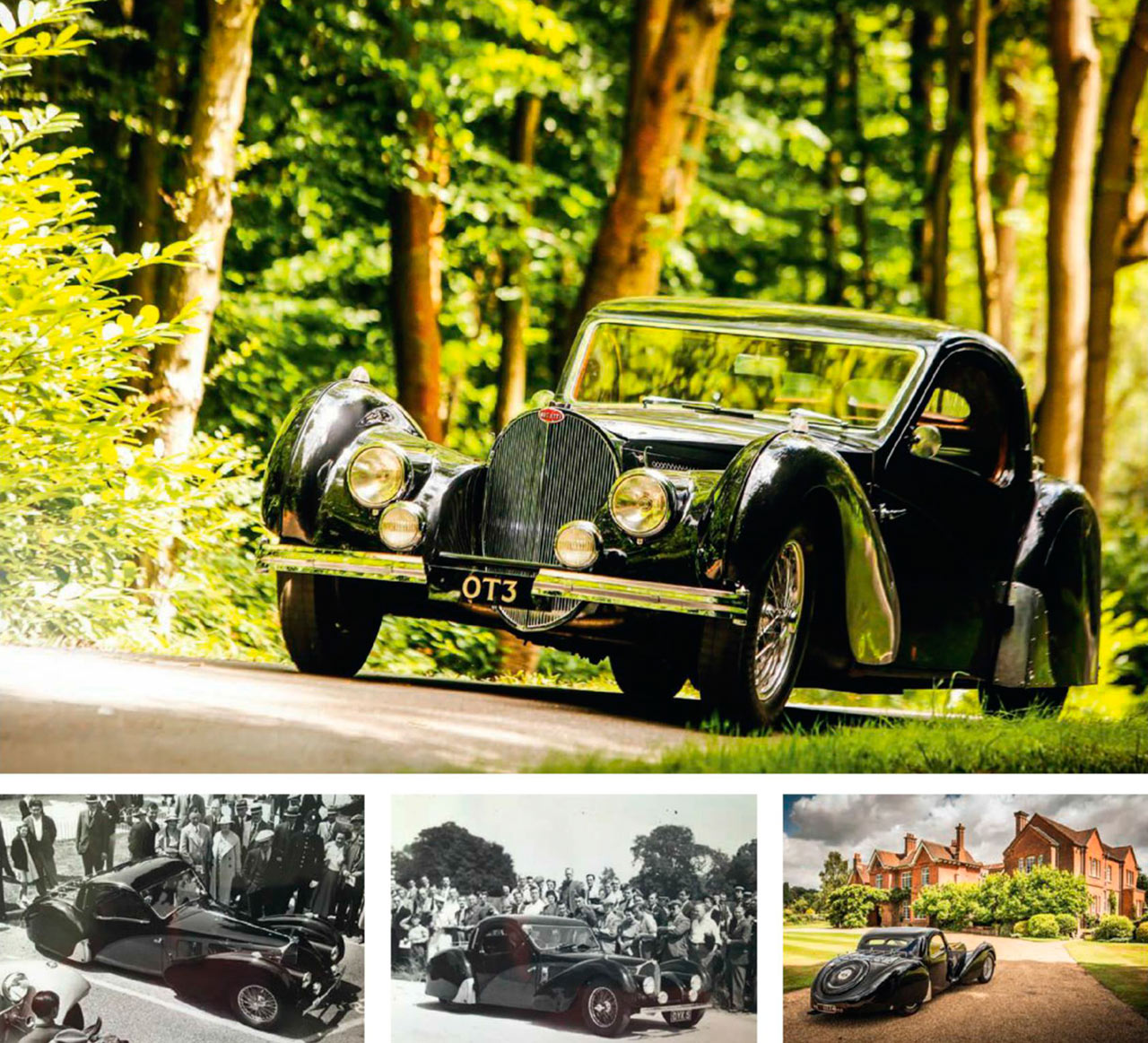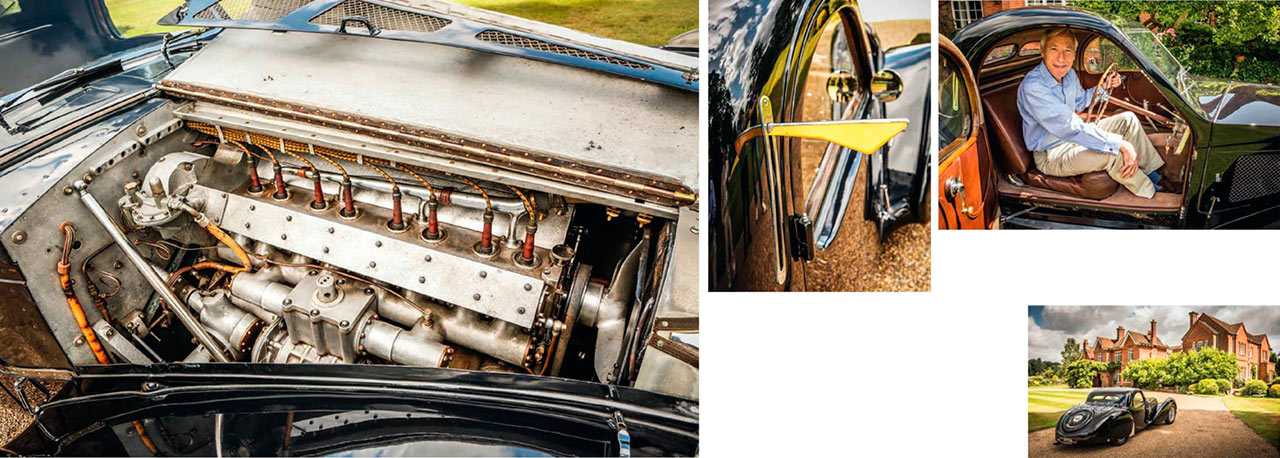
Exclusive Bugatti test Earl Howe masterpiece. Mick Walsh recounts the rebuild of a spectacular Bugatti T57 Atalante. Aristocrat’s Atalante The exactingly restored exEarl Howe Bugatti returns to its former home. To the manor, Reborn. Mick Walsh follows the tracks of Earl Howe in the painstakingly restored Bugatti Type 57S Atalante that once sped up this same driveway. Photography Tony Baker/LAT/Bonhams.
As soon as the stunning blue-black Bugatti pulls out of specialist Ivan Dutton’s Oxfordshire base, it’s as if the supercharged coupé knows its way back to first owner Earl Howe’s estate. The return of the restored 1937 exotic to Penn House in Buckinghamshire to meet the present Earl Howe – great nephew of the racing aristocrat – has long been planned and, as soon as the road opens up, the straight-eight roars away. The expression of the modern Peugeot driver as the pre-war coupé flashes past is priceless. After just a few miles, I conclude that this Atalante is the finest and fastest roadgoing Bugatti I’ve driven – maybe even the best-ever pre-war road car.

Clockwise: current Earl with Bugatti – note split bumpers instead of single (above); removable cluster gives access to magneto.
Atalantes are renowned for cooking their occupants, but Tim Dutton and I are still cool in the exquisitely furnished cockpit after a spirited 30-minute run. All the way I babble on to Dutton about the staggering, smooth performance, the slick close-ratio gearbox and the superbly weighted steering. “We don’t let other customers experience this car because it would spoil them for everything else,” says the Bugatti specialist, who is rightfully proud of the job his team has done with this rediscovered jewel.
As we enter the gateway to the legendary drive built through the woods by Howe, it feels extra special to run in this fantastic car’s early wheeltracks. Elderly locals still recall the sound of the Bugatti howling back here late at night before Howe’s final rapid blast up his private test course.
The car is well-known to the present Earl Howe, who has researched his great uncle’s road cars. Frederick Curzon and his wife Elizabeth appear to greet the returning pre-war supercar as soon as the Bugatti noisily enters the gravel circle in front of the house. “I sadly never met him,” says the seventh Earl Howe, “but on visits here as a boy I’d hear stories about this ferocious gentleman who wouldn’t tolerate fools. He never fully recovered from the ERA accident at Brooklands in 1937, and suffered for the rest of his life.”

Clockwise, from below: clumsy back bumper was removed, revealing the Atalante’s elegant curves; door card design was confirmed as bespoke to Howe in a period photo; closely spaced pedals.
After tea and shortbread, Dutton takes Howe for a run around the local roads and allows him a drive. As he steps from the cockpit, the elated Earl is as impressed as me by the 80-year-old coupé: “The performance and sound are amazing. It must have felt like a spaceship in 1937!”
The immaculate condition of the Type 57S couldn’t be further removed from when it was pulled out of its Yorkshire hiding place 10 years ago. Once the Atalante had been secured in the much-publicised Bonhams Paris auction in the Grand Palais during Rétromobile, February 2009, the discussions began about how to restore the famous car. Every owner up to Newcastlebased doctor Harold Carr had left their mark on the Bugatti’s development. Like Howe and the Atalante’s second keeper John P Tingay, who had the engine modified to SC tune with a Marshall K200 supercharger, new owner Hubert Fabri has his own ideas about aesthetics and specification – as well as a respect for this important vehicle’s history. Carr had done little to the Bugatti other than dismantle it after problems with the brakes, and stored it for half a century.
The pre-sale press coverage emphasised the untouched state of the Atalante, after it had been exhumed from its Newcastle lair. It was photographed in a studio for C&SC’s March ’09 issue.
Fabri had a long association with Ivan Dutton Limited, previously entrusting the firm with the preservation of two highly original Bugattis, a Type 35 and the ex-King Leopold Type 59/50B.
As with the racers, a key factor was a thorough mechanical rebuild so that the car could be enthusiastically driven. Unlike the other projects, though, the Atalante was tatty, somewhat unloved but very complete. In honour of Howe, who was fanatical about the smart, distinctive presentation of his vehicles, it was conclusively felt that the Atalante should be rebuilt to ‘as new’. It was unmolested but scruffy, so the initial priority was to strip and investigate the chassis and the more complex bodywork.

Clockwise: owner Fabri sourced a suitable shade of pigskin hide, which also shrouds steering column, but all the Molsheim cabin woodwork was reused; exquisite handle and latch; Earl Howe’s luggage rack.
For the first few months, the car remained as it was while Fabri and Dutton faced a fascinating quandary over which direction the project should take. Still untouched, 57502 was even shown in a Type 57S class in the Cartier Style et Luxe at Goodwood. It created more interest than the restored ex-Dr Williamson Atalante (the next one built at Molsheim in 1937), which had sold the previous year for a staggering $7.9 million. Should the car be returned to exactly as Howe drove it, with the two-tone black over blue paint, crude side vents, ugly bumpers and bench seats?
If this was the case, then the blower should also be removed, although Dutton argued that the expertly installed upgrade by Tingay in the late ’40s was as much part of the Bugatti’s character as the removable dashboard centre cluster fitted by Howe for quick access to the Scintilla magneto. Eventually, they decided that the project should incorporate key elements from the Atalante’s evolution including the non- Molsheim supercharger. The philosophy was to produce a finished car that both reflected its colourful past and was also a superb driving machine with practical refinements to make it more enjoyable on today’s roads.
The debate about the colour was typical of the passions of all involved. The original Howe paint had long gone, the ardent racer having instructed Mike Oliver of Continental Cars that the Bugatti should be repainted maroon over his signature blue before it was offered for sale in ’47 with a £2000 price tag. Dutton had suggested a two-tone maroon over dark blue to echo previous schemes, while the others maintained that it should remain black. In the end, Fabri decided on a single deep shade of blue that better highlights Jean Bugatti’s brilliant styling.
Close investigation revealed a repair to the rear after Howe’s road accident in 1945, and structural wood problems due mostly to the animal glue drying and joints coming apart. The only solution was to remove the aluminium outer skin, so that the frame could be repaired with securely rebonded joints.
“The structure was the biggest challenge,” says Dutton. “Everything was scanned before we took it apart, so the body fitted perfectly when the car was reassembled. Other than small repairs at the back, most of the frame and shell are original. It would have been easier to make new wood but that wasn’t an option here.”

Clockwise: Bugatti is superbly poised; a proud return to Penn House; the overhauled trafficators; Howe, with immaculate Atalante at ’1937 concours in Eastbourne; Gransden Lodge, 10 years later.
There are few Bugattis that Dutton hasn’t sampled, but he’s never forgotten a frustrating drive in David Heimann’s Type 57S ‘57.592’ as a teenager. “I cooked in the cockpit after just half a mile on a summer day,” Dutton recalls. “The heat and the noise made the car undrivable.
That’s why you rarely see Atalantes going beyond the concours ramp, and we were determined to resolve that.” Willie Green had a similar experience in the Atlantic now owned by Ralph Lauren, and claimed that the noise and heat made it one of the worst cars he’d driven.
Howe clearly suffered similar discomfort, particularly when wearing his tailored suits and blazers, which is why he soon had chrome vents crudely cut into the rear bonnet sides to release engine heat. Dutton thought long and hard about a discreet way to keep out the heat and reduce the noise. The solution was 3mm-thick, NASA-grade ceramic insulation, which is invisible but could easily be removed – like all of the subtle alterations made by Dutton’s specialist craftsmen. The material predictably wasn’t cheap (about £2000, says Dutton), but has transformed the cockpit experience as we discovered on a baking-hot summer run.
The cabin provided a further dilemma, but close scrutiny of a photograph of Howe having lunch in the Atalante at Donington in 1937 confirmed a different style of door card, so the interior had been changed at some point. The unique dashboard design was well preserved, but, rather than Howe’s modified bench (he felt that the factory design wasn’t supportive enough), Fabri decided to have replica Bugatti seats made. The interior was retrimmed by Bob Smith, a former Rolls-Royce upholsterer with P&A Wood. Owner Fabri went to great lengths to find a suitable brown leather and eventually sourced pigskin hides in America. All of the wood trim and instruments were refitted after preservation and even the glass was reused.
As Dutton explains: “Everyone always thought that the coffee-coloured stains were down to Howe’s smoking [the car came with two ashtrays because he was never without a cigarette, often in a stylish holder], but it’s just the celluloid discolouring inside the old glass.” Other impressive details include the scratchbuilt blue-tinted visors, roller rear-window blinds and a leather steering-column shroud to avoid reflections in the windscreen.
Authenticity was key throughout the restoration, but, because the Atalante was to be driven in the manner in which it was conceived, certain features, including the wiper motor, were uprated. “You need a proper wiper at 100mph, and the modification is all hidden away,” says Dutton. But the split windscreen post, which is prone to cracking the paint and often adjusted on concours cars, was kept just as Molsheim’s craftsmen had fabricated it. Robert Dean, a former boat builder, was entrusted with the woodwork.
Several of Howe’s cosmetic body tweaks have been changed, but only where it was felt that such details spoilt the elegant flowing lines. Hefty one-piece chromed bumpers had been fitted early in Howe’s ownership, but Fabri decided to put these aside and remake Bugatti’s more attractive two-piece front type. The rear was left exposed like many of the 17 Type 57S Atalantes had been finished. Howe’s distinctive chrome boot rack and twin spotlights were all retained, however. Opening the bootlid latches proved fiddly with the rack fitted, causing rapped knuckles, until one of Dutton’s team found an old railway carriage key that does the job perfectly. The semaphore indicators fitted into the roof sides were also retained and repaired.
As with the bodywork, the chassis was stripped down for a thorough check and overhaul. New crank, pistons and Carrillo rods were fitted while it was further refined with a fluid-filled damper to the front. “The original design was fine until it got wet, but this makes a big difference,” says Dutton. “The engine gives about 200bhp, with really impressive mid-range torque.”

Right: the current Earl has been researching his ancestor’s cars and was impressed after a drive. Below: straight-eight was rebuilt but with original finish; note neat Marshall supercharger installation.
As with many customers’ Bugattis that are regularly driven, Dutton fitted an overdrive to the Atalante: “It was pretty low geared, which suited pre-war roads, but you now get the best of both worlds. It knocks a third off when cruising, with 70mph at only 2500rpm.” The switch is cleverly disguised inside the centre console. The chassis rebuild included sorting the broken back axle, which was one of the reasons why previous owner Carr took the Atalante off the road, while the complex De Ram dampers were meticulously rebuilt. Each unit has more than 300 parts.
Once the body was refitted and the colour agreed, the Atalante went to Bicester Bodyshop for a cellulose respray. To complete the final appearance – and for safer driving – a set of chromed Borrani wire wheels was ordered that authentically matched Howe’s preferred design.
“Hubert is the perfect customer who trusts our judgment,” says Dutton. “He doesn’t try to micro-manage, but is totally passionate about the project. Like us, he’s not interested in faking patina and, if the car is regularly driven, it soon settles and looks real. The ‘discovered’ condition wouldn’t do justice to this work of art, and wouldn’t reflect Howe’s personality. We wanted a finished Bugatti that the owner would choose over a modern Audi A8 for a run to the south of France simply because he loved driving it.”
Dutton tried to get Howe’s original registration ‘DYK 5’ for the final touch. After tracing it to a modern Bentley, contact was made with the keeper via the DVLA but he wasn’t interested in selling. Fabri then decided on a period-style ‘OT 3’, which was elegantly hand-painted.
The Atalante was restored not to become another precious Bugatti concours queen. When work started, the milometer read just 26,000, which Dutton reckons was correct, and it has clocked up another enthusiastic 10,000 miles since completion: “Howe bought the car to drive and felt that it was fast enough without the added complication of the supercharger. Everyone wants the SC spec now, but too many have become exclusive toys that rarely get used. Even unsupercharged, the Atalante has comparable performance to an XK120 and, in 1936, a Type 57S was one of the fastest cars on British roads.”
Dutton has taken 57502 back and forth to Switzerland four times for the owner, preferring to drive to Geneva rather than transport this valuable car. “It’ll cruise happily at 80mph at relaxed revs with the overdrive,” he enthuses. “I’ve had it up to 120mph just to see what it was like. The chassis runs perfectly straight and stable. The performance is really good, but the brakes are the only limiting factor. It just won’t stand on its nose if a truck suddenly pulls out, and that’s always at the back of your mind. For me, it’s the finest road car of the era, and the Alfa 2.9 – with its poor gearbox and horrible suspension design – is no match. The Type 57S really should have been called a Type 59 Sports because it’s much closer in detail. The gearbox is lovely and the live rear axle works beautifully.”
The fact that this glorious machine is still used exactly how Jean and Ettore conceived it is encouraging news in an age of unbelievable values. Just imagine motoring along a route nationale in the autumn, and suddenly this sleek blue-black beauty appears in the rear-view mirror. Just to see it and hear it roar past would be as magical as being behind the wheel.
‘“IT MUST HAVE FELT LIKE A SPACESHIP IN 1937!” SAYS THE CURRENT EARL AFTER A DRIVE’
‘IT WAS RESTORED AS A CAR TO BE DRIVEN AND HAS DONE 10,000 MILES SINCE COMPLETION’





